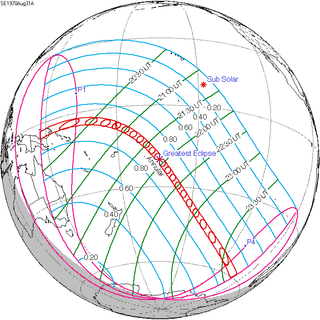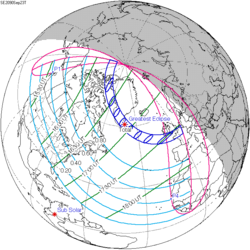Top Qs
Timeline
Chat
Perspective
Solar eclipse of August 31, 1970
20th-century annular solar eclipse From Wikipedia, the free encyclopedia
Remove ads
An annular solar eclipse occurred at the Moon's descending node of orbit between Monday, August 31 and Tuesday, September 1, 1970,[1] with a magnitude of 0.94. A solar eclipse occurs when the Moon passes between Earth and the Sun, thereby totally or partly obscuring the image of the Sun for a viewer on Earth. An annular solar eclipse occurs when the Moon's apparent diameter is smaller than the Sun's, blocking most of the Sun's light and causing the Sun to look like an annulus (ring). An annular eclipse appears as a partial eclipse over a region of the Earth thousands of kilometres wide. Occurring about 20 hours after apogee (on August 31, 1970, at 2:00 UTC), the Moon's apparent diameter was smaller.[2]
Annularity was visible from the Territory of Papua and New Guinea (today's Papua New Guinea), Gilbert and Ellice Islands (the part that belongs to Tuvalu now) on September 1 (Tuesday), West Samoa (name changed to Samoa later) and the whole American Samoa except Swains Island on August 31 (Monday). A partial eclipse was visible for parts of Eastern Australia, Oceania, and Antarctica.
Remove ads
Eclipse details
Summarize
Perspective
Shown below are two tables displaying details about this particular solar eclipse. The first table outlines times at which the moon's penumbra or umbra attains the specific parameter, and the second table describes various other parameters pertaining to this eclipse.[3]
Remove ads
Eclipse season
This eclipse is part of an eclipse season, a period, roughly every six months, when eclipses occur. Only two (or occasionally three) eclipse seasons occur each year, and each season lasts about 35 days and repeats just short of six months (173 days) later; thus two full eclipse seasons always occur each year. Either two or three eclipses happen each eclipse season. In the sequence below, each eclipse is separated by a fortnight.
Remove ads
Related eclipses
Eclipses in 1970
- A partial lunar eclipse on February 21.
- A total solar eclipse on March 7.
- A partial lunar eclipse on August 17.
- An annular solar eclipse on August 31.
Metonic
- Preceded by: Solar eclipse of November 12, 1966
- Followed by: Solar eclipse of June 20, 1974
Tzolkinex
- Preceded by: Solar eclipse of July 20, 1963
- Followed by: Solar eclipse of October 12, 1977
Half-Saros
- Preceded by: Lunar eclipse of August 26, 1961
- Followed by: Lunar eclipse of September 6, 1979
Tritos
- Preceded by: Solar eclipse of October 2, 1959
- Followed by: Solar eclipse of July 31, 1981
Solar Saros 144
- Preceded by: Solar eclipse of August 20, 1952
- Followed by: Solar eclipse of September 11, 1988
Inex
- Preceded by: Solar eclipse of September 21, 1941
- Followed by: Solar eclipse of August 11, 1999
Triad
- Preceded by: Solar eclipse of October 30, 1883
- Followed by: Solar eclipse of July 1, 2057
Solar eclipses of 1968–1971
This eclipse is a member of a semester series. An eclipse in a semester series of solar eclipses repeats approximately every 177 days and 4 hours (a semester) at alternating nodes of the Moon's orbit.[4]
The partial solar eclipse on July 22, 1971 occurs in the next lunar year eclipse set.
Saros 144
This eclipse is a part of Saros series 144, repeating every 18 years, 11 days, and containing 70 events. The series started with a partial solar eclipse on April 11, 1736. It contains annular eclipses from July 7, 1880 through August 27, 2565. There are no hybrid or total eclipses in this set. The series ends at member 70 as a partial eclipse on May 5, 2980. Its eclipses are tabulated in three columns; every third eclipse in the same column is one exeligmos apart, so they all cast shadows over approximately the same parts of the Earth.
The longest duration of annularity will be produced by member 51 at 9 minutes, 52 seconds on December 29, 2168. All eclipses in this series occur at the Moon’s descending node of orbit.[5]
Metonic series
The metonic series repeats eclipses every 19 years (6939.69 days), lasting about 5 cycles. Eclipses occur in nearly the same calendar date. In addition, the octon subseries repeats 1/5 of that or every 3.8 years (1387.94 days). All eclipses in this table occur at the Moon's descending node.
Tritos series
This eclipse is a part of a tritos cycle, repeating at alternating nodes every 135 synodic months (≈ 3986.63 days, or 11 years minus 1 month). Their appearance and longitude are irregular due to a lack of synchronization with the anomalistic month (period of perigee), but groupings of 3 tritos cycles (≈ 33 years minus 3 months) come close (≈ 434.044 anomalistic months), so eclipses are similar in these groupings.
The partial solar eclipses on December 18, 2188 (part of Saros 164) and November 18, 2199 (part of Saros 165) are also a part of this series but are not included in the table below.
Inex series
This eclipse is a part of the long period inex cycle, repeating at alternating nodes, every 358 synodic months (≈ 10,571.95 days, or 29 years minus 20 days). Their appearance and longitude are irregular due to a lack of synchronization with the anomalistic month (period of perigee). However, groupings of 3 inex cycles (≈ 87 years minus 2 months) comes close (≈ 1,151.02 anomalistic months), so eclipses are similar in these groupings.
Remove ads
Notes
References
Wikiwand - on
Seamless Wikipedia browsing. On steroids.
Remove ads































































































